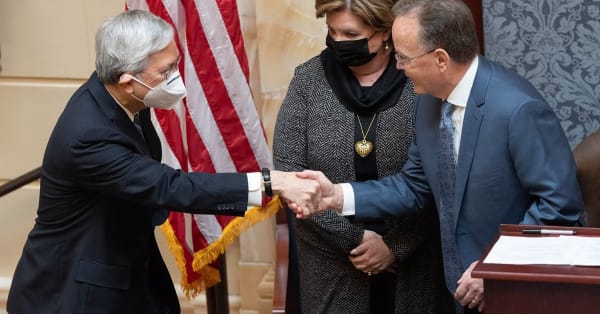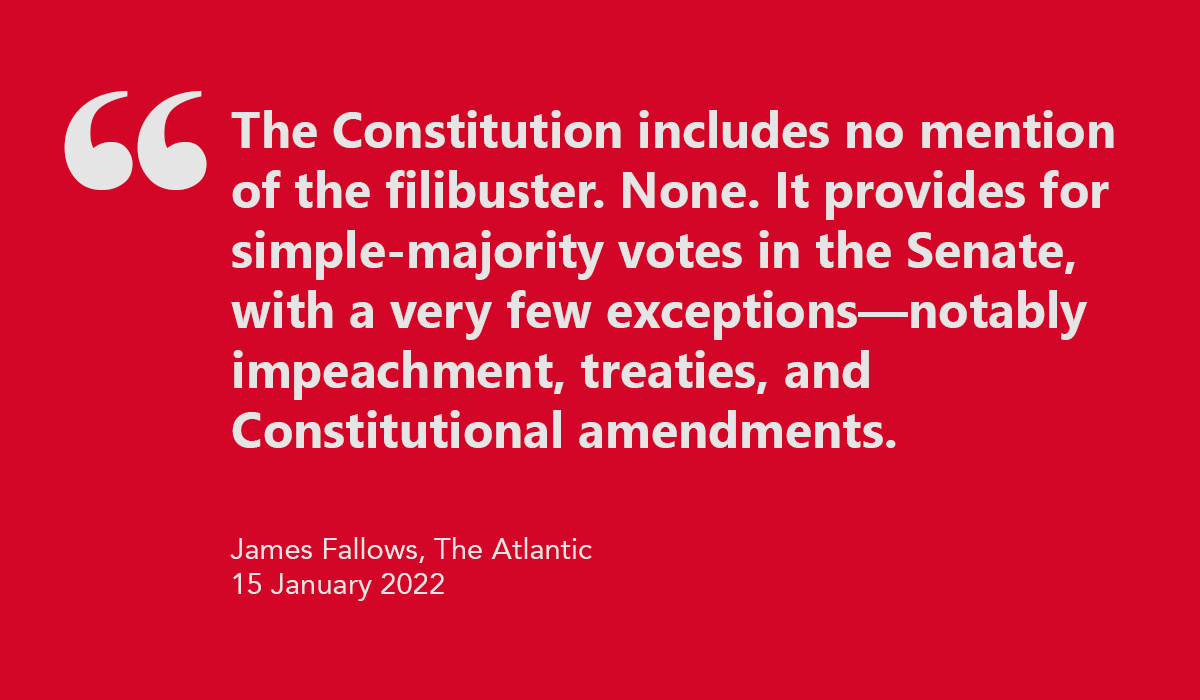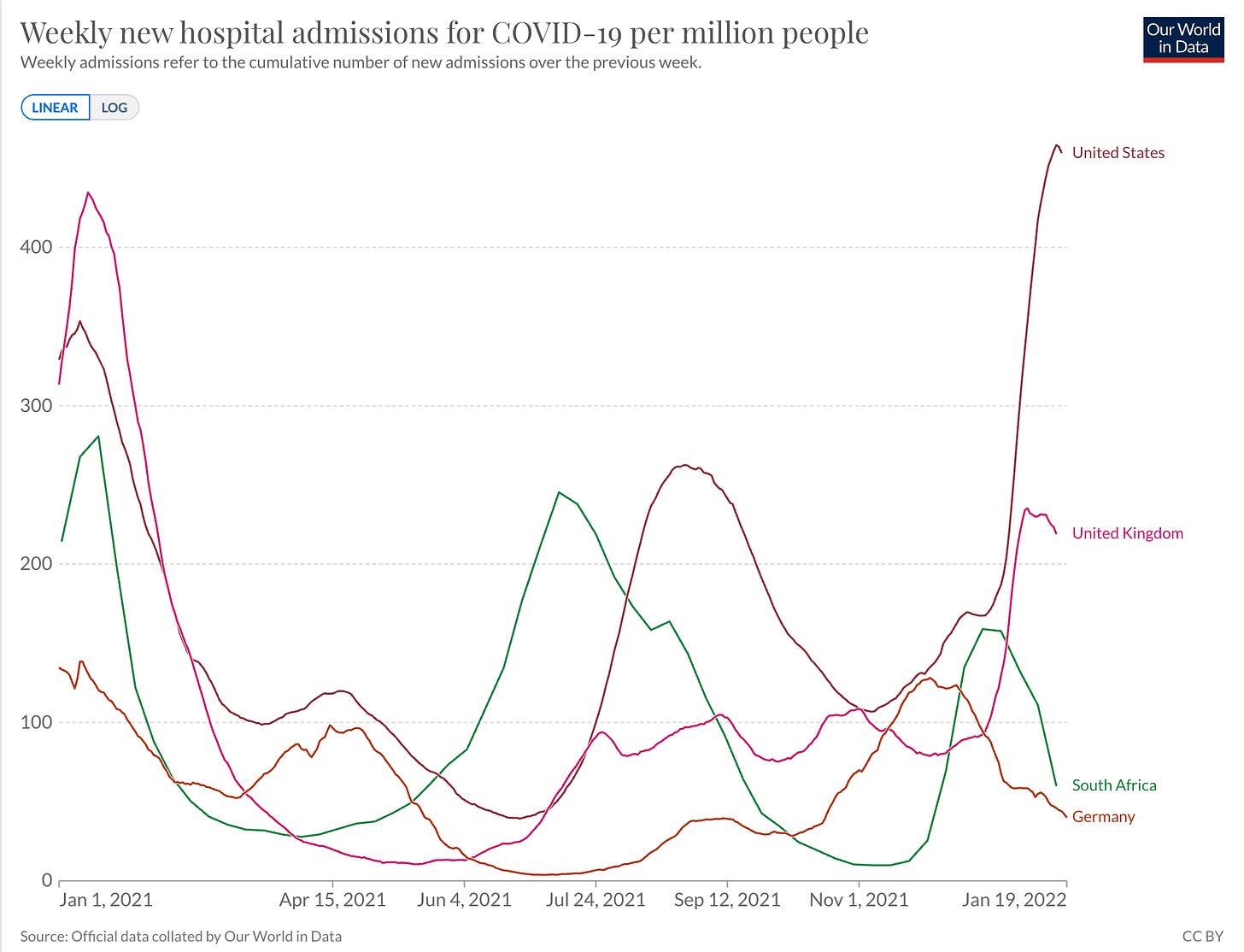20 January 2022 ⚡️We need a vaccine against the filibuster
Omicron cases may have peaked; hospitalizations have set a new record. Although Biden's free tests and masks strategy has kicked off, its help with Omicron is debatable.
If you’re following US politics, you know that Republicans in the Senate are acting as a block to stop electoral reform. They haven’t voting against the John R. Lewis Act, per se. They voted to prevent their having to actually vote against the bill.
Senate Majority Leader Chuck Schumer (D-NY) sought to change the rules for the filibuster. With a change back to a talking filibuster (not a waiver), Republicans would actually have had to debate the bill, not just mimic Reagan and “just say no.”
That’s when Sen. Joe Manchin (D-WV) and Sen. Krysten Sinema (D-AZ) joined the GOP to block releasing the John R. Lewis Act from the chains of the filibuster (52-48).
Congress passed the Voting Rights Act in 1965. It reauthorized the law in 1970, 1975, 1982 and 2006. Each time, Congress gave the bill overwhelming bipartisan support. Each bill was signed into law by a Republican president.
But that was then. Before Trump. Before obstruction was the only word when not in power; making the rich richer, the only act when in power.
Welcome to the messed up world of minority rule.
The GOP hasn’t represented a majority of American citizens since 1996. James Fallows has an excellent filibuster primer at The Atlantic and a reminder that the filibuster is not in the Constitution. It has been used primarily by White Supremacists since the Civil War. Like it’s being used now.
TURNING to Covid-19, boosters have a limited timeline for protection against infection (also no surprise). Just like the initial vaccines. However even when infection protection wanes, they continue to protect against severe disease and hospitalization.
After three months, a Covid-19 booster reduces the risk of a symptomatic infection by about 50%, according to this UK research. However, protection against hospitalization remains at about 80% even after four months.
In the US, most people hospitalized with Covid-19 have not been vaccinated; fully vaccinated means boosted.

⓵ One big thing
Omicron cases in the United States may have peaked. Reported cases for 19 January 2022: 2,268 per 100,000. On the 15th, it was 2,427, three times the pre-vaccine peak.
The previous peak was 757 cases on 11 January 2021, long before widespread vaccine availability. At that time, at-home tests were not a thing and it wasn’t that difficult to schedule a PCR test.
We know that the actual number of people infected with Omicron is far greater than the official PCR reports.
Hospitalizations and deaths, on the other hand, will probably peak in February. Vaccines have had a major impact on case fatality rates. At its peak post-vaccines, the case fatality rate in the US was 2.9% (March 2021). It’s currently about 0.25% but it was 2.32% in December.
Hospitalization reports lag case numbers. As of January 14th, we had about 456 Covid-19 patients per 1 million people in US hospitals. That’s more than last year’s peak of 400 in January 2021. Far more people are being hospitalized in the US than in the UK.
In addition, the back side of these curves isn’t usually as steep as their start. For example, in South Africa deaths are continuing to climb although reported cases peaked in mid-December 2021.
Top 10 states ranked by 7-day average of new Covid-19 cases per 100,000 population:
Rhode Island (1.1 million ) - 437
Wisconsin (5.9 million) - 398
Kansas (2.9 million) - 386
Utah (3.3 million) - 341
South Carolina (5.1 million) - 338
Hawaii (1.5 million) - 315
Nevada (3.1 million) - 313
North Carolina (10.4 million) - 307
Alaska (733,000) - 306
Arkansas (3.0 million) - 292
The bottom 10: Maine (68), Idaho (119), Maryland (123), Montana (133), DC (150), Georgia (161), Connecticut (173), Pennsylvania (174) and Iowa (175).
⓶ Update on Biden’s get-a-test-kit + free masks
You can now order up to four Covid-19 tests per household at COVIDtests.gov or from USPS. This is independent of your trying to get reimbursed for at-home tests from your health insurance carrier, Medicare excepted.
Want to know how many people are on that site right now?


I truly don’t know who is really in charge of Covid-19 strategy for the White House, but whomever it is should be replaced. The team got off to a good start in 2021, but seems to have been floundering since mid-year. These test kits will be arriving just as this surge declines.
Then there is the N95 mask give-away. Last week, the CDC updated its guidance on masks, advising that N95 respirators are more effective at preventing transmission than either cloth or surgical masks. Nevertheless, wearing any mask is better than no mask, the CDC says. Here’s a chart on how to wear your N95.
When I saw my PCP for my annual physical on Monday, he told me that it was the first day that staff had been upgraded to N95s.
Here are the masks we keep in the house and car:
Kimberly-Clark N95 Pouch Respirator (53358), NIOSH-Approved, made in the US. This is also known as a “duckbill” mask; recommended by WireCutter. It is made in-country, not in China, but resembles the Chinese KN95 and is not designed for health care use despite that NIOSH approval. All N95 masks have headbands to provide the best seal, not ear loops.
Bella Premium Hanji Mask, KF94, made in Korea. Their 5-pack is no longer available; it was a less expensive way to try this mask. When buying a KF94 (KF means Korean Filter), make sure it is made in South Korea and not China.
LG Airwasher KF94 Mask, KF94, made in Korea. It has an adjustable ear loop.
What’s important is how tightly the mask fits your face size and shape. Here’s a chart on how to fit/wear your new mask. Tips for spotting fake masks.
⓷ You can’t make this stuff up
This is the Republican president of the Utah Senate, Stuart Adams. Notice the missing mask.


The man tested positive for COVID-19 last Thursday morning, negative on Monday, and positive twice on Tuesday. CDC guidelines are clear that after isolating for at least five days, someone who tests positive should wear a mask for an additional five days to prevent the spread of the virus.
Utah currently ranks fourth in the country in per capita cases. But the GOP-led legislature is moving a bill to ban local government mask mandates.
On Sunday, the Salt Lake Tribune editorial board bluntly and pointedly wrote about the woeful lack of public leadership two years into dealing with Covid-19.


And from Hong Kong:


⓸ A personal note
Most of my professional life has been dedicated to a medium that didn’t exist when I was in college. This tweet about the NYT contextualizes my having created a website with its own domain name for the 1996 Washington state gubernatorial primaries.


Talk to me!
Let me know what is happening in your community. Share news clinks, Twitter threads, (public) Facebook posts.
👓 See COVID-19 resource collection at WiredPen / See all newsletters
👓 See primary news sources







